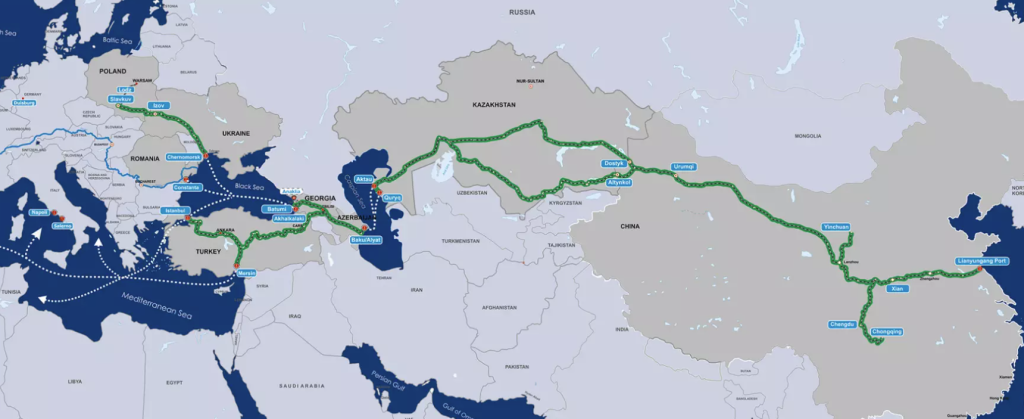
Central Asia to the South Caucasus: Newfound Connectivity Relevance of the Middle Corridor
Russia’s war against Ukraine was a turning point – not only in a political and cultural sense, but for global supply chains as well. The shock of the Russian attack was felt in most countries that were once part of the Soviet Union, especially in the Southern Caucasus and Central Asia.
The author: Nico Butylin is a German journalist from Berliner Zeitung working with Civil.ge in the framework of the IJP Scholarship
90 million people live in these eight states – Georgia, Armenia and Azerbaijan, in South Caucasus and Kazakhstan, Turkmenistan, Uzbekistan, Tajikistan and Kyrgyzstan, in Central Asia. Together they cover an area almost the size of Europe. Often referred to simply as post-Soviet, the outlines of a new order can be recognized: they are no longer just “Moscow’s backyard”.
The whole region, from the port city of Batumi on Georgia’s Black Sea to the vast expanses of Kazakhstan’s steppe, is becoming increasingly important with a potential reach to the West, China, Turkey and on to the Arabian Peninsula. Until the Russian war, most global players were very much in favor of all trade going through Russia. “Logistically, it was simply cheaper and more efficient,” says Temur Umarov of the Carnegie Russia Eurasia Centre. There was little interest in other routes.
Both Europe and China, the Central Asia expert explains, were fully satisfied with the existing supply chains via Siberia, the so-called Northern Corridor. From the well-developed railway network to the economic structures that had been consolidated over decades. The Russian war changed the perspective. But “you can’t completely change logistics overnight,” says Umarov. “It’s not possible, either in terms of price or organization.”

As the need for alternative transport and trade routes grows, the Central Asian and South Caucasian states are now offering them. For almost two years now, politicians, various industries and academics have been talking about the Middle Corridor. The new east-west axis starts in China and runs through Central Asia to the Caspian Sea; once in Azerbaijan, it continues through the South Caucasus, with Georgia potentially becoming a major hub. In March 2022, a Trans-Caspian East-West Middle Corridor was signed by Georgia, Azerbaijan, Turkey and Kazakhstan was signed by Georgia, Azerbaijan, Turkey and Kazakhstan, emphasizing the importance of steps to strengthen the transit potential of the signatory states.
Although the two regions are separated by the Caspian Sea – the world’s largest lake – more supply chains and new oil and gas routes have been created to link them. Georgia, with its geographical location between Azerbaijan and the Caspian Sea on the one hand, and Turkey and the Black Sea on the other, could become the new main hub of this new Middle Corridor.
Regional connectivity has increased significantly. Politics, business and even societies in Central Asia and the South Caucasus have come closer together. There are daily flights from Georgia and Azerbaijan to Kazakhstan and Uzbekistan. New logistics companies are being set up in Tbilisi, Samarkand and Astana, and deep-sea ports and new railway stations are being planned. Delegations from the countries are visiting each other, and relations are deepening.
The growing importance of the Middle Corridor is also reflected in the intensity and level of discussion. At the end of October, the Tbilisi Silk Road Forum brought together decision-makers from China, Central Asia, the Arabian Peninsula and the Southern Caucasus. The prime ministers of Georgia, Armenia, Azerbaijan and Montenegro attended, as did ministers from Serbia, the United Arab Emirates and Turkey, as well as representatives of the Asian Development Bank and major financial institutions.
Moreover, the governments in Baku, Tbilisi, Astana and Tashkent are emphasizing their multi-vector foreign policy approach. They want to cooperate with the West, with China and the Arab states. But Russia also remains an important trading partner. Incidentally, none of the eight states in the South Caucasus and Central Asia has joined the West’s sanctions policy against Moscow.
“The countries that (re)gained independence after the collapse of the Soviet Union have taken different political or economic paths in the years since the USSR’s dissolution,” says Stefan Meister of the German Council on Foreign Relations.
Wars, and ethnic and territorial conflicts have been a part everyday life for many decades; the Nagorno-Karabakh war between Armenia and Azerbaijan is the most recent conflict to illustrate the lack of sustainable peace in the region. ”But as a result of the Russian war against Ukraine, there is a greater interest in working together, especially with regard to transit and increased connectivity to Europe,” says Meister.
The foreign and security policy expert, who specializes in Russia, the South Caucasus and Central Asia, believes that this is precisely the reason why the number of meetings between the heads of state has increased in recent months. As recently as the end of September Federal Chancellor Olaf Scholz (SPD) received the five heads of state of the Central Asian countries, and meetings have also taken place with the heads of state of the South Caucasus states Irakli Garibashvili, Nikol Pashinyan and Ilham Aliyev.
Foreign Minister Annalena Baerbock (Greens) has visited Tbilisi, Tashkent and Astana. “The South Caucasus and Central Asia are key partners for both Germany and China as an alternative to Russia,” says Meister. This offers further perspectives for the development of the Middle Corridor in the future.